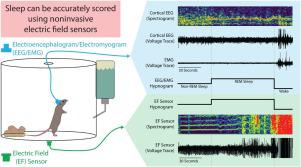Journal of Neuroscience Methods ( IF 2.7 ) Pub Date : 2020-06-30 , DOI: 10.1016/j.jneumeth.2020.108834 H Kloefkorn 1 , L M Aiani 2 , A Lakhani 1 , S Nagesh 3 , A Moss 1 , W Goolsby 1 , J M Rehg 4 , N P Pedersen 2 , S Hochman 1

|
Study Objective
Validate a novel method for sleep-wake staging in mice using noninvasive electric field (EF) sensors.
Methods
Mice were implanted with electroencephalogram (EEG) and electromyogram (EMG) electrodes and housed individually. Noninvasive EF sensors were attached to the exterior of each chamber to record respiration and other movement simultaneously with EEG, EMG, and video. A sleep-wake scoring method based on EF sensor data was developed with reference to EEG/EMG and then validated by three expert scorers. Additionally, novice scorers without sleep-wake scoring experience were self-trained to score sleep using only the EF sensor data, and results were compared to those from expert scorers. Lastly, ability to capture three-state sleep-wake staging with EF sensors attached to traditional mouse home-cages was tested.
Results
EF sensors quantified wake, rapid eye movement (REM) sleep, and non-REM sleep with high agreement (>93%) and comparable inter- and intra-scorer error as EEG/EMG. Novice scorers successfully learned sleep-wake scoring using only EF sensor data and scoring criteria, and achieved high agreement with expert scorers (>91%). When applied to traditional home-cages, EF sensors enabled classification of three-state (wake, NREM and REM) sleep-wake independent of EEG/EMG.
Conclusions
EF sensors score three-state sleep-wake architecture with high agreement to conventional EEG/EMG sleep-wake scoring 1) without invasive surgery, 2) from outside the home-cage, and 3) and without requiring specialized training or equipment. EF sensors provide an alternative method to assess rodent sleep for animal models and research laboratories in which EEG/EMG is not possible or where noninvasive approaches are preferred.
中文翻译:

使用电场传感器对小鼠进行无创三态睡眠-觉醒分期。
学习目的
验证一种使用无创电场 (EF) 传感器对小鼠进行睡眠-觉醒分期的新方法。
方法
小鼠被植入脑电图(EEG)和肌电图(EMG)电极并单独饲养。无创 EF 传感器连接到每个腔室的外部,以与脑电图、肌电图和视频同时记录呼吸和其他运动。参考 EEG/EMG 开发了一种基于 EF 传感器数据的睡眠-觉醒评分方法,然后由三位专家评分员进行验证。此外,没有睡眠-觉醒评分经验的新手评分者经过自我训练,仅使用 EF 传感器数据对睡眠进行评分,并将结果与专家评分者的结果进行比较。最后,测试了使用连接到传统小鼠笼的 EF 传感器捕获三态睡眠-觉醒阶段的能力。
结果
EF 传感器对唤醒、快速眼动 (REM) 睡眠和非快速眼动睡眠进行量化,与 EEG/EMG 具有高度一致性 (>93%) 和可比的评分者间和评分者内误差。新手评分者仅使用 EF 传感器数据和评分标准即可成功学习睡眠-觉醒评分,并与专家评分者达成高度一致 (>91%)。当应用于传统的家用笼时,EF 传感器能够对独立于 EEG/EMG 的三态(唤醒、NREM 和 REM)睡眠-觉醒进行分类。
结论
EF 传感器对三态睡眠-觉醒架构进行评分,与传统 EEG/EMG 睡眠-觉醒评分高度一致:1) 无需侵入性手术,2) 在笼外进行,3) 无需专门培训或设备。 EF 传感器为无法进行脑电图/肌电图或首选非侵入性方法的动物模型和研究实验室提供了一种评估啮齿动物睡眠的替代方法。











































 京公网安备 11010802027423号
京公网安备 11010802027423号